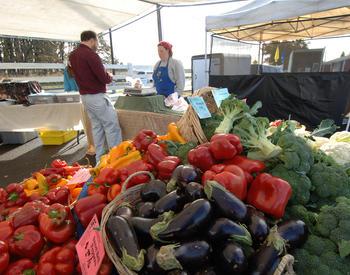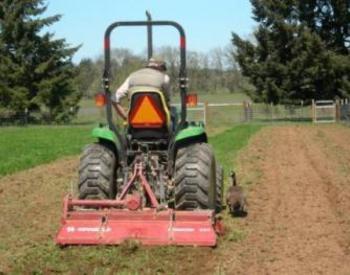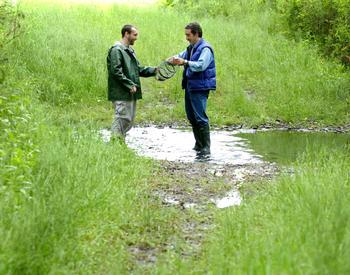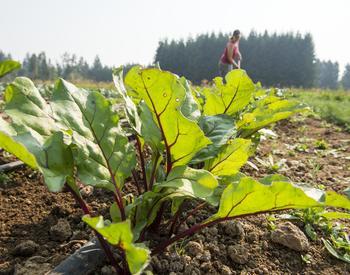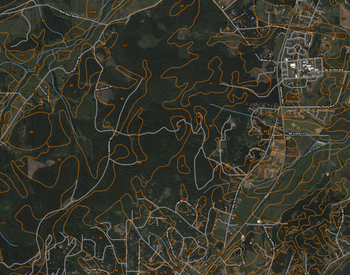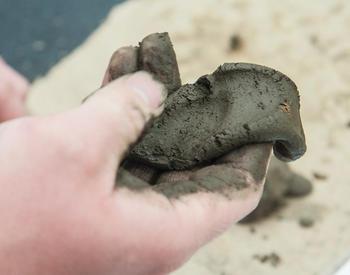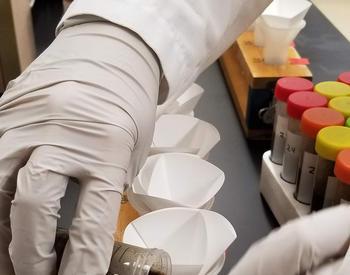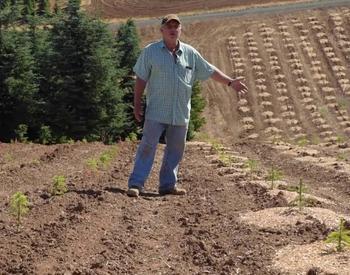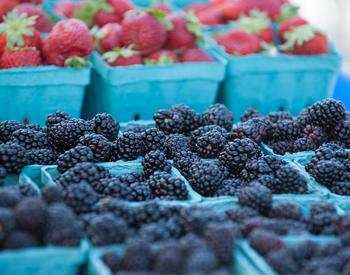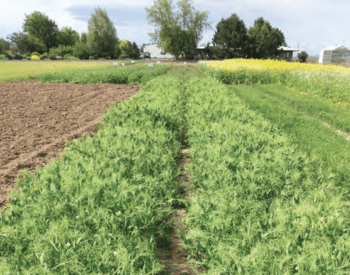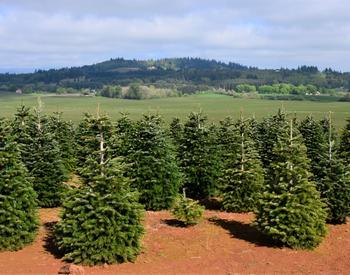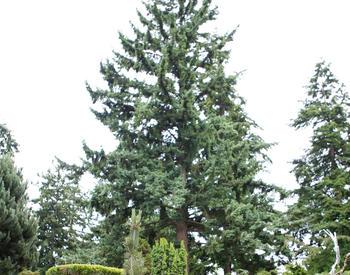Most Christmas tree growers fertilize with nitrogen (N) intending to improve tree color, growth, and ultimately value.
Where does the fertilizer go after application? How much is actually taken up by the trees, stored in the soil or lost to the environment? How much N is removed at harvest? Should growers be concerned about depletion of soil N reserves from repeated rotations? These are some of the questions investigated in this study.
The study was done in 1991 and 1992 under a grant from the Center for Applied Agricultural Research (CAAR). Matching dollars were provided by the Pacific Northwest Christmas Tree Association, via on-going cooperative fertilizer research with Oregon State University and Washington State University.
The study site
Research plots were established in a third rotation Douglas-fir Christmas tree plantation, eight miles east of Salem, Oregon, in the central Willamette Valley.
This site was chosen because it was also the location of one of the nine test sites for the Pacific Northwest Christmas Tree Association fertilizer study on Douglas-fir. This allowed comparing N movement with and without previous fertilization.
The field was managed in a typical fashion, with tree spacing at 5.5 feet by 5.5 feet. Soil was a 35-inch deep silty clay loam. In late March, a water table was encountered at a depth of 30 inches.
During the 385-day study period, the rainfall was 52 percent greater than normal for the first four months of the study and 32 percent less than normal for the last ten months of the study. Averaged over the entire study, precipitation was 15 percent less than normal (Figure 1), but was within the normal range of precipitation for Douglas-fir.
Experimental methods
The experimental design consisted of two blocks of six trees each (Figure 2). One block had been fertilized each March for the previous five years using ureasul (33-0-0-12). Total amount of N applied over the five-year period was 390 pounds. This plot is referred to as 390+N. The other block received no N fertilization prior to this study. This plot is referred to as 0+N.
Perimeters of the treatment blocks were trenched to a depth of 30 inches, lined with black plastic, and backfilled (Figure 3).
While this trenching severed lateral roots extending more than 2.5 feet on two sides of the trees, the exact impact of this on the trees is unknown. Growth of trees with severed roots was not observed to be obviously different from that of off-plot trees with non-severed roots.
A liquid solution of ammonium sulfate (21-0-0-24), providing 150 lb N/acre, was applied on March 26, 1991 (Figure 4).
The fertilizer solution contained a stable, non-radioactive isotope of N that could be used to trace the movement of N into trees and through soil.
At the conclusion of the study, roots were extracted following a technique perfected by Mike Newton, Oregon State university professor. Dynamite was used to loosen and lift the root systems out of the ground (Figures 5 and 6).
Results: Distribution and loss of N fertilizer
The uptake and loss of N fertilizer was similar for trees with previous fertilization (390+N) and those without (0+N). The expectation was that previous fertilization of the 390+N plots would have enriched the soil and trees with available N.
Consequently, the trees would have been expected to use less of the applied fertilizer N.
No difference is interpreted to mean that N from previous applications was not present or available in the soil. Further, the demand for N from previously fertilized trees was no less than for trees not previously fertilized.
At the end of this study, 21 percent of the N fertilizer was found in the trees, 30 percent remained in the soil, and the balance, 49 percent, was lost from the site (Figure 7). The amount of N lost was considerably higher than expected.
In a similar study (Heilman et. Al. 1982) in young forest plantations approximately 32 percent of the applied N fertilizer was not taken up by the trees or found in the soil and was presumably lost from the site.
In another study under forest conditions, Cole and Gessel (1965) found very little N was lost from fertilizer they applied to a fully vegetated forest site.
So, where does the N not found in the tree or soil go? Volatization, denitrification, and leaching are the usual explanations.
Volatization can occur when unrebased fertilizers are applied in the late winter and early spring. Warm soil and air conditions can cause gaseous ammonia to be released from the fertilizer directly into the atmosphere. Applying liquid ammonium sulfate, as done in this study, should have minimized any volatization loss.
Denitrification is a natural process that occurs when soil microorganisms convert nitrate forms of N into nitrogen gas, which escapes into the air. This process occurs most commonly in saturated soil conditions, especially near the water table in the soil profile. Denitrification may be responsible for ten percent or more of the N reported lost in this study.
Leaching results when the nutrients move below the root zone and, ultimately, into the water table. Nitrate forms of N move easily through the soil, especially during periods of high rainfall. Most losses observed in this study were attributed to leaching for two reasons.
First, the abnormally high rainfall shortly after application (52% above normal) likely pushed the fertilizer N lower in the soil profile than would be expected in a normal year. At this lower location, the nitrogen was more likely to be leached below the root zone the following winter or denitrified in the saturated soil zone near the water table.
Secondly, a 40 percent decrease in recoverable nitrogen in the soil was observed between sample dates November 1991 and April 1992 (Figure 8).
This loss came at a time when plant uptake is very slow and rainfall amounts for the year are very high, leading to the belief that N was lost to leaching.
Tree uptake of fertilizer N vs. soil N
Based on measured N content in sample trees, uptake of total N was estimated to be 210 lb N/acre. The portions of this total amount estimated to have been accumulated over time are shown by Figure 9. This curve was based on the presumption that Christmas tree biomass growth is similar to a young forest plantation which from research at OSU has been found to double annually.
A further presumption is that N uptake follows with biomass growth. From this curve, uptake in year 7 was determined to be 100 lb N/acre. Of this mount, 32 lb N/acre, or 32 percent, was conclusively traced to the fertilizer, with the balance, 68 lb N/acre, coming from the soil N reserves.
Worth of note is that the trees drew about two-thirds of their annual need from soil reserves, even though they were supplied with fertilizer N (150 lb N/acre) in excess of their annual needs.
Nitrogen distribution and removal at harvest
Figure 10 illustrates the distribution of N in various parts of the Christmas tree. Of the 210 lb N/acre present, 178 lb N/acre would be removed at harvest.
So why worry about adding N fertilizer if only 178 lb N/acre is removed in needles, branches, and stems during harvest?
With over 11,000 lb N/acre present in soil reserves, only 1.6 percent of this is removed (Table 1).
| Soil Depth (inches) | Total Nitrogen (lb N/acre) |
|---|---|
| 0-8 | 4,626 |
| 8-16 | 3,400 |
| 16-24 | 3,000 |
| Total | 1,026 |
Growers may not need to be overly concerned with depletion of soil N reserves over a few rotations of Christmas trees, but they should pay close attention to whether the annual requirement of N by the trees is greater than the soil can make available from its vast reserves.
Conclusions
Nitrogen fertilizer, where does it go? This study measured 21 percent used by the trees and 30 percent stored in the soil, while it was estimated that up to 40 percent was lost by leaching and 10 percent or more was suspected to have been lost by denitrification.
Because of heavier than normal rainfall in the four months following fertilizer application, and because of root pruning incurred during plot installation, leaching losses may have been greater than typical.
In spite of these reservations, growers should be aware that significant leaching losses are a real possibility.
They should use fertilization practices which maximize the opportunity for N uptake and minimize leaching.
One strategy would be to apply multiple smaller annual doses of N fertilizer, rather than only one or two large doses over the rotation. Another strategy is to use foliar testing, rather than guessing, to determine whether or not, and how much, fertilizer is needed.
Target fertilizer application so that N is available for the active foliage growth, which occurs between April and July.
With urea products, fertilize in February or March so that N becomes available in April and May. For nitrates, fertilize in April to early May to minimize leaching losses and meet immediate growth needs.
References and further reading
- What’s Nitrogen Fertilizer Buying You? Bondi, M. et. Al. 1993. Christmas Tree Lookout, Winter, p. 18-28
- Fertilizing Douglas-fir Christmas Trees. Bondi, M. et. Al. 1995. OSU Fertilizer Guide #73.
- Movement of Elements Through a Forest Soil as Influenced by Tree Removal and Fertilizer Additions. Cole, D. W and S. P. Gessel, 1965. In C. T. Youngberg (ed) Forest Soil Relationships in North America, p. 95-105. Oregon State University Press, Corvallis.
- Comparison of Fall and Spring Applications of N-15 Labeled Urea to Douglas-fir: 1. Growth Response and Nitrogen Levels in Foliage and Soil. Heilman, P. et. Al. 1982. Soil Science Society of America Journal. 46:1293-1299
- Using Fertilizers in the Culture of Christmas Trees. McEvoy, T.J. 1992. Paragon Books, Richmond, VD.
- Mineral Deficiencies of Coastal Northwest Conifers. Walker, R.B. and S.P. Gessel, 1991. Institute of Forest Resources Contribution 70. College of Forest Resources, University of Washington, Seattle.

